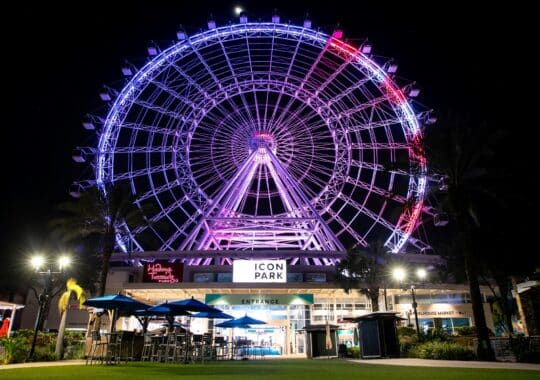|
Getting your Trinity Audio player ready...
|
Creating a dining atmosphere that delights patrons as soon as they step through the door is as crucial as the culinary masterpieces served on the plates. The captivating allure of a restaurant is not only dished out by its menu but also by the charm of its environment, calling for a thoughtful design that encapsulates a memorable dining experience. Understanding the dynamics of successful restaurant space design is the key to attracting and retaining a loyal clientele. Keep reading to explore the essential tips for curating a space that will resonate with your guests and set the scene for exquisite dining encounters.
Top Latest Orlando Hotel Offers
- Ramada Plaza Resort International Drive : Get 60% Off and Experience the Magic of Halloween!
- Holiday Inn Express South Lake Buena Vista > Experience the ultimate family getaway.
- Rosen Inn Lake Buena Vista > Comfortable Accommodations Await You in Orlando.
- Rosen Inn Pointe Orlando > Everything You Need – Without Resort Fees!
- Rosen Inn International Drive > Centrally located on the bustling International Drive.
- Hampton Inn Kissimmee North - Just off US-441, we are within two miles of several restaurants and shops at The Crosslands and Loop West.
- Best Western Plus Universal Studios - Located directly across from Universal Studios®, Harry Potter®, the Island of Adventure®.

Balancing Aesthetics and Functionality for Restaurant Layouts
The layout of your restaurant is a subtle yet powerful tool that weaves functionality into the aesthetic appeal. A floor plan must cater to efficient service routes, comfortable traffic flow, and kitchen accessibility while maintaining an appealing visual coherence. Getting this balance right can amplify the dining pleasure and streamline operations, proving that form and function are two sides of the same coin in successful restaurant design.
Kitchen design and bar placement merit particular attention since these elements form the backbone of the dining experience. LA Restaurant Equipment plays a pivotal role in outfitting these areas with the right tools for seamless operation. The strategic placement of equipment can streamline service, reduce mishaps, and ensure a pleasant experience both for staff and patrons.
Selecting the Right Color Palette and Lighting for Mood Setting
Color and lighting are the maestros of mood-setting within a restaurant. The right color palette can evoke emotional responses and create visual stimuli that enhance the dining experience. Warm tones might invite a sense of comfort and appetite piquing, while cool shades could suggest sophistication and calm. Selecting the appropriate color scheme can attract your target demographic and set the tone for their meal before they even glance at the menu.
When physical lighting fixtures are part of the decorative scheme, they should match the mood intended for the setting. Creative fixtures can double as art installations, actively contributing to the theme and overall ambiance. Spaces seeking to infuse a sense of nature might incorporate fake olive trees for a touch of greenery that can be enhanced with strategically placed lights to cast evocative shadows, thereby enriching the sensory experience further.
Ambiance in Restaurant Design
The first bite is with the eye. That’s why restaurant ambiance is more than just background; it’s a vital ingredient of the dining experience. A well-designed ambiance can enhance the perceived quality of food, encourage customer loyalty, and even justify premium pricing. Lighting, music, and décor work in concert to set the tone, whether it’s a relaxed bistro or a high-end eatery, to ensure that every meal is served with a side of atmosphere.
Creating the right ambiance also involves understanding the psychology of your diners. Warm colors can stimulate appetite, while cool hues might promote a more relaxed setting. The bustle of open kitchens and bar areas can energize a space, whereas intimate booths and soft furnishings can offer a haven of privacy. The key is to align the atmosphere with the expectations and comfort of your target audience.
Optimizing Table Arrangements and Seating for Guest Comfort and Efficiency
As the heart of the dining room, table arrangements play a critical role in marrying customer comfort with restaurant efficiency. A clever layout can optimize space, improve service speed, and ensure guest privacy without sacrificing the inviting open feel of the dining area. Considerations such as table size and shapes, spacing between them, and the relationship to service stations must be deliberate to foster an environment conducive to both diner satisfaction and operational fluidity.
Seating ergonomics is equally important. Comfortable seating encourages longer stays and potentially more orders per table, which could lead to increased profitability. The choice of chairs, booths, and benches must offer comfort and maintain the design aesthetic, contributing to the overall appeal of your restaurant. Proper seating arrangements also reflect the consideration given to customer needs, enhancing their overall experience.
Overall, designing a restaurant space that resonates with your brand while providing a comfortable and efficient experience for guests is an art form. Striking just the right balance between ambiance, functionality, aesthetic identity, mood setting, and guest comfort is integral for cultivating a successful dining environment. By keeping these pivotal design considerations in mind, restaurateurs can craft spaces that are not only visually stunning but also operationally effective, setting the stage for memorable culinary journeys for every patron who walks through their doors.



